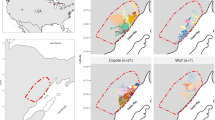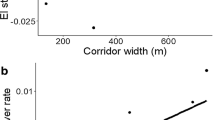Abstract
Corridor function for wildlife movement constitutes an important and desirable ecological characteristic of linear landscape structures. Changes in the matrix conditions, however, may result in substantial changes in the mechanisms responsible for the use of corridors by animals. I developed a model that describes the influence of matrix quality on the effectiveness of corridors for wildlife movement and the abundance of animals in the corridors. The model predicts that corridor effectiveness is maximized at intermediate matrix quality levels, while the abundance in the corridor increases asymptotically with matrix quality. I tested predictions of this model by comparing the expected and observed relative abundance of forest bird species in two landscape types of southern Chile. In nine out of 12 cases the model correctly predicted the relative abundance of forest birds. Riparian forest strips were expected to be effective functioning as corridors for five out of six studied species, although corridor effectiveness for each species varied between landscape types. A reasonable strategy to improve connectivity is to maintain (or to increase, if necessary) the matrix quality at a level such that corridors can function efficiently as both drift fences and movement conduits.





Similar content being viewed by others
References
Baum KA, Haynes KJ, Dillemuth FP, Cronin JT (2004) The matrix enhances the effectiveness of corridors and stepping stones. Ecology 85:2671–2676
Beier P, Noss RF (1998) Do habitat corridors provide connectivity? Conserv Biol 12:1241–1252
Bennett AF (1998) Movements of animals through linkages. In: Bennett AF (ed) Linkages in the landscape: the role of corridors and connectivity in wildlife conservation. IUCN, Gland, Switzerland, pp 67–91
Berggren A, Birath B, Kindvall O (2002) Effect of corridors and habitat edges on dispersal behavior, movement rates, and movement angles in Roesel’s Bush-Cricket (Metrioptera roeseli). Conserv Biol 16:1562–1569
Buckland ST, Anderson DR, Burnham KP, Laake JL, Borchers DL, Thomas L (2001) Introduction to distance sampling: estimating abundance of biological populations. Oxford University Press, Oxford
Chetkiewicz C-LB, St. Clair CC, Boyce MS (2006) Corridors for conservation: integrating pattern and process. Annu Rev Ecol Evol Syst 37:317–342
Cronin JT, Haynes KJ, Dillemuth FP (2004) Spider effects on planthopper mortality, dispersal, and spatial population dynamics. Ecology 85:2134–2143
Davies ZG, Pullin AS (2007) Are hedgerows effective corridors between fragments of woodland habitat? An evidence-based approach. Landscape Ecol 22:333–351
Desrochers A, Hannon SJ, Nordin KE (1988) Winter survival and territory acquisition in a northern population of Black-capped Chickadees. Auk 105:727–736
Diefenbach DR, Brauning DW, Mattice JA (2003) Variability in grassland bird counts related to observer differences and species detection rates. Auk 120:1168–1179
Donoso C (1993) Bosques templados de Chile y Argentina: variación, estructura y dinámica. Editorial Universitaria Santiago, Chile
Dunning JB, Danielson BJ, Pulliam HR (1992) Ecological processes that affect populations in complex landscapes. Oikos 65:169–175
Estades CF (1997) Bird-habitat relationships in a vegetational gradient in the Andes of central Chile. Condor 99:719–727
Estades CF (2001) The effect of breeding-habitat patch size on bird population density. Landscape Ecol 16:161–173
Fahrig L (2001) How much habitat is enough? Biol Conserv 100:65–74
Fahrig L (2003) Effects of habitat fragmentation on biodiversity. Ann Rev Ecol Syst 34:487–515
Fahrig L (2007) Landscape heterogeneity and metapopulation dynamics. In: Wu J, Hobbs RJ (eds) Key topics and perspectives in landscape ecology. Cambridge University Press, Cambridge, pp 78–89
Forman RTT (1995) Land mosaics: the ecology of landscapes and regions. Cambridge University Press, Cambridge
Fried JH, Levey DJ, Hogsette JA (2005) Habitat corridors function as both drift fences and movement conduits for dispersing flies. Oecologia 143(4):645–651
Gelling M, Macdonald DW, Mathews F (2007) Are hedgerows the route to increased farmland small mammal density? Use of hedgerows in British pastoral habitats. Landscape Ecol 22:1019–1032
Haddad NM, Baum K (1999) An experimental test of corridor effects on butterfly densities. Ecol Appl 9:623–633
Haddad NM, Tewksbury JJ (2005) Low quality habitat corridors as movement conduits for two butterfly species. Ecol Appl 15:250–257
Haddad NM, Bowne DR, Cunningham A, Danielson B, Levey D, Sargent S, Spira T (2003) Corridor use by diverse taxa. Ecology 84:609–615
Harrison RL (1992) Toward a theory of inter-refuge corridor design. Conserv Biol 6:293–295
Horskins K, Mather PB, Wilson JC (2006) Corridors and connectivity: when use and function do not equate. Landscape Ecol 21:641–655
Hudgens BR, Haddad NM (2003) Predicting which species will benefit from corridors in fragmented landscapes from population growth models. Am Nat 161:808–820
Link WA, Sauer JR (2002) A hierarchical analysis of population change with application to Cerulean Warblers. Ecology 83:2832–2840
Mceuen A (1993) The wildlife corridor controversy: a review. Endanger Species Update 10:1–7
Öckinger E, Smith H (2008) Do corridors promote dispersal in grassland butterflies and other insects? Landscape Ecol 23:27–40
Perault DR, Lomolino MV (2000) Corridors and mammal community structure across a fragmented, old-growth forest landscape. Ecol Monogr 70:401–422
Ralph CJ (1985) Habitat association patterns of forest and steppe birds of northern Patagonia, Argentina. Condor 87:471–483
Reino L, Beja P, Osborne PE, Morgado R, Fabião A, Rotenberry JT (2009) Distance to edges, edge contrast and landscape fragmentation: interactions affecting farmland birds around forest plantations. Biol Conserv 142:824–838
Ricketts TH (2001) The matrix matters: effective isolation in fragmented landscapes. Am Nat 158:87–99
Rosenberg DK, Noon BR, Meslow EC (1997) Biological corridors: form, function, and efficacy. Bioscience 47:677–687
Saunders DA, Hobbs RJ (1991) Nature conservation 2: the role of corridors. Surrey Beatty & Sons, Chipping Norton
Schippers P, Grashof-Bokdam CJ, Verboom J, Baveco JM, Jochem R, Meeuwsen HAM, Van Adrichem MHC (2009) Sacrificing patches for linear habitat elements enhances metapopulation performance of woodland birds in fragmented landscapes. Landscape Ecol 24:1123–1133
Simberloff D, Farr JA, Cox J, Mehlam DW (1992) Movement corridors: conservation bargains or poor investments? Conserv Biol 6:493–502
Stamps JA, Buechner M, Krishnan VV (1987) The effects of edge permeability and habitat geometry on emigration from patches of habitat. Am Nat 129:533–552
Sturtz S, Ligges U, Gelman A (2005) R2WinBUGS: a package for running WinBUGS from R. J Stat Softw 12:1–16
Tewksbury JJ, Levey DJ, Haddad NM, Sargent S, Orrock JL, Weldon A (2002) Corridors affect plants, animals, and their interactions in fragmented landscapes. Proc Natl Acad Sci USA 99:12923–12926
Thomas L, Buckland ST, Burnham KP, Anderson DR, Laake JL, Borchers DL, Strindberg S (2002) Distance sampling. In: El-Shaarawi AH, Piegorsch WW (eds) Encyclopedia of environmetrics. John Wiley and Sons, Chichester, pp 544–552
Tubelis DP, Cowling A, Donnelly C (2004) Landscape supplementation in adjacent savannas and its implications for the design of corridors for forest birds in the central Cerrado, Brazil. Biol Conserv 118:353–364
Vergara PM, Armesto JJ (2009) Responses of Chilean forest birds to anthropogenic habitat fragmentation across spatial scales. Landscape Ecol 24:25–38
Vergara PM, Hahn I (2009) Linking edge effects and patch size effects: importance of matrix nest predators. Ecol Model 220:1189–1196
Vergara PM, Marquet PA (2007) On the seasonal effect of landscape structure on a bird species: the thorn-tailed rayadito in a relict forest in northern Chile. Landscape Ecol 22:1059–1071
Vergara PM, Simonetti JA (2006) Abundance and movement of understory birds in maulino forest fragmented by pine plantations. Biodivers Conserv 15:39–47
Vergara PM, Smith C, Delpiano C, Orellana I, Gho D (2010a) Frugivory on Persea lingue in temperate Chilean forests: interactions between fruit availability and habitat fragmentation across multiple spatial scales. Oecología 164(4):981–991. doi:10.1007/s00442-010-1722-1
Vergara PM, Jimenez J, Schlatter RP (2010b) Effective point-count duration for Chilean forest birds. Zool Stud 49:381–391
Vuilleumier F (1967) Mixed species flocks in Patagonian forest, with remarks on interspecies flock formation. Condor 64:400–404
Acknowledgments
This study was supported by FONDECYT under project 11080085. I thank Ignacio Orellana for his valuable help in data collection, and Forestal Mininco for granting us access to forest fragments. I thank two anonymous reviewers for their valuable and constructive comments.
Author information
Authors and Affiliations
Corresponding author
Electronic supplementary material
Below is the link to the electronic supplementary material.
Rights and permissions
About this article
Cite this article
Vergara, P.M. Matrix-dependent corridor effectiveness and the abundance of forest birds in fragmented landscapes. Landscape Ecol 26, 1085–1096 (2011). https://doi.org/10.1007/s10980-011-9641-z
Received:
Accepted:
Published:
Issue Date:
DOI: https://doi.org/10.1007/s10980-011-9641-z




